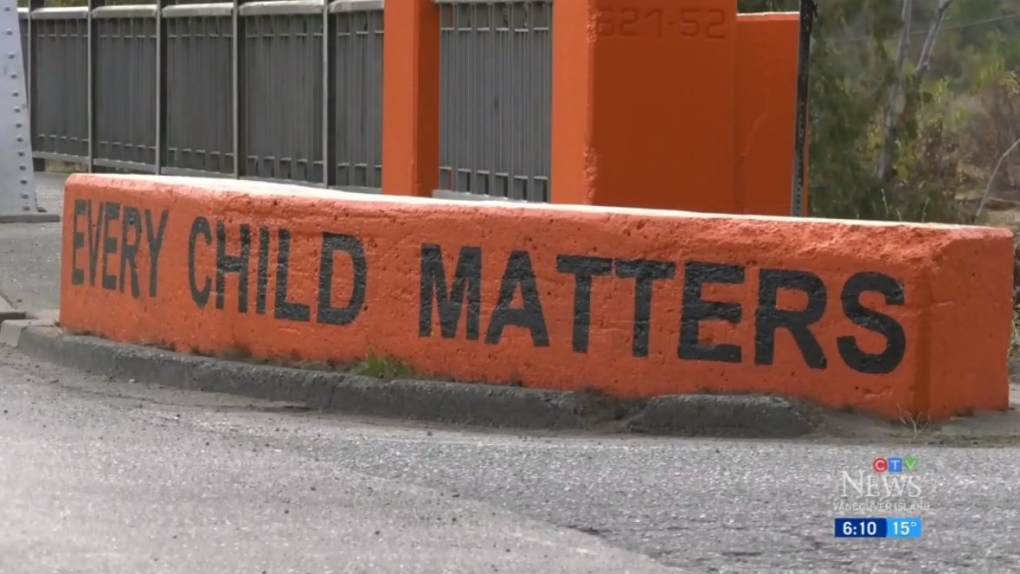Vancouver Island First Nation paints bridge orange in honour of residential school students
Ahead of the second National Day of Truth and Reconciliation on Friday, a Vancouver Island First Nation is working to make a local bridge with a dark past more welcoming.
It's known as the "Orange Bridge" to many of the locals in the Port Alberni, B.C., area.
"There's a lot of survivors who won't come to Port Alberni and who won't cross this bridge because it reminds them of this school," said Ken Watts, Elected Chief Councillor of the Tseshaht First Nation.
Heading west along Highway 4, the Orange Bridge crosses the Somass River and enters the Tseshaht First Nation where the Alberni Indian Residential School once sat just a few hundred metres away.
The bridge is a constant reminder to survivors of what happened there.
"Many kids crossed the bridge. They were considered runaways," said Wally Samuel, an Alberni Indian Residential School survivor.
Another survivor, Donna Samuel, says most people had no idea what the bridge meant to survivors.
But that will hopefully start to change. On Tuesday, survivors – with help from the B.C. Ministry of Transportation and Main Road Contracting – painted the four corners of the bridge orange to honour all of the children who attended the school.
 The "Orange Bridge" is pictured in Port Alberni, B.C. (CTV News)
The "Orange Bridge" is pictured in Port Alberni, B.C. (CTV News)
"It's a part of our healing journey," said Wally.
"I'm glad to be doing this today as a reminder," added Donna.
Chief Watts says the bridge is intended to stand as a symbol for current and future generations.
"We need to remind people when they pass this bridge about what happened here, and also the resilience of our people and how we have survived," he said.
But the job won't be complete without involving the next generation. Educators have to teach what the orange paint symbolizes, and the National Day of Truth and Reconciliation is an important part of that.
"It's a day for people who went to residential [schools] and survived, and people who did not," said Riley Stewart, a student at Haahuupayak Elementary School.
"And a lot of the elders are still alive and used to go there and they lost their culture," added student Heexal Dennis Marshel.
CTVNews.ca Top Stories

A father who stayed by his son's bedside were among the victims in California's wildfires
An amputee and his son with cerebral palsy were among the 11 deaths in the fires raging around Los Angeles. The father was found at his son’s bedside.
'Thankful for the rest of my life': Woman's final goodbye with father captured on video at Winnipeg airport
One woman is expressing her deepest gratitude to the Winnipeg Richardson International Airport after the staff helped her retrieve the security footage of her final moments with her father.
U.S. special counsel Jack Smith has resigned
U.S. Special counsel Jack Smith has resigned from the Justice Department effective Friday, according to a court filing.
Visualizing the Los Angeles wildfires in maps and charts
A series of life-threatening fires, the largest of which is in the Pacific Palisades, are destroying homes as they race across Los Angeles County and surrounding areas.
Former B.C. premier says she 'misspoke' when claiming she was never a Conservative
Former British Columbia premier Christy Clark, who is considering a run for federal Liberal leader, has backtracked on her claim this week that she'd never been a member of the Conservative party.
UPDATED Anita Anand will not seek Liberal leadership
Transport Minister Anita Anand announced on social media Saturday she will not seek the leadership of the Liberal Party, nor will she run for re-election in the riding of Oakville.
Lone sailor trapped in ice sparks concern in Southern Georgian Bay
A lone sailor living on a sailboat trapped in the Georgian Bay ice has sparked concern among Penetanguishene residents.
This Canadian teen lost her hands and feet, she says more people should know how it happened
A Canadian teen is reaching audiences around the world with powerful social media videos showing life without hands and feet – the price she paid after developing sepsis.
'It's not realistic': Former PM Chretien thinks Trump will back off trade war
Former prime minister Jean Chretien says U.S. president-elect Donald Trump is likely to walk back his threat of punishing tariffs and the resulting trade war with Canada, because the Americans are too reliant on a number of Canadian exports, namely in the energy sector.
































